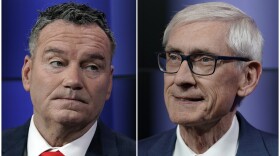Wisconsin’s midterm election races were extremely tight, but in the end, Wisconsin once again elected Democratic Governor Tony Evers and Republican U.S. Senator Ron Johnson.
The results show the true colors of Wisconsin aren’t red or blue, but a deep shade of purple.
“Wisconsin is an extremely competitive state,” says UW-Madison Journalism Professor Mike Wagner. “It gets outsized spending from outside of the state because of how close our elections are and because of how important the results of our elections are, both for state and national policy making. So, it wasn’t at all surprising to see two very close races.”
Wagner says the state’s path to purple has been long but steady, and it’s become so divided for a number of reasons.
For one, he says the Republican party has made inroads in rural Wisconsin, which hasn’t historically been the case.
“There’s been a slight resorting of the electorate,” he explains. “Some people who had been more favorable to Democratic party politicians, mainly white working-class voters without a college education, have become more likely to vote for Republican candidates in the last few decades.”
Wagner also says big donors are more likely to contribute to campaigns in Wisconsin because the races are so close. That leads to extremely negative campaigns across the state which further polarize voters.
However, some people in Wisconsin still split their vote between Democrats and Republicans. That’s how the state managed to elect both a Democratic governor and a Republican senator in the same election.
“Over the last several decades, more and more people vote straight line party tickets, but not everybody does,” Wagner says. “The two parties don’t match every single person’s issue portfolio perfectly, and there are some people who are willing to split their tickets when they vote. It’s somewhere between 2 and 8 percent of the electorate in Wisconsin in any given election season.”
Wagner’s research shows those people are more likely to seek out diverse sources of information and have political discussions with people they disagree with.
No matter which direction Wisconsin’s elections tilt in the end, Wagner says one benefit of living in such a purple state is that more people exercise their right to vote.
“In communities where there’s lots of information, and you can register to vote on Election Day and the election is going to be close, there tends to be really high participation,” he says. “That’s something else our state tends to enjoy as compared to other states.”







